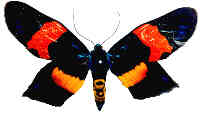The male adults can often be found imbibing water, minerals and organic compounds of animal dung, dead animals, decaying vegetable matter, mud and sand along roads, puddles and creeks. The females visit flowers, especially of Eucalyptus deglupta and Dysoxylum sp. where they drink nectar. Two days after copulation the female lays eggs singly at the base of the host’s needles. The hatched brown looper caterpillars have yellow stripes and feed on the surface of the needles and branches. The feeding traces are quite inconspicuous during the first few larval instars and resemble the damage caused by skeletonizers or miners. Older caterpillars leave serrate feeding traces on the needles or reduce the leaves to a stub. A severe infestation of a host tree causes massive defoliation so that the tree appears brown from a distance. For pupation, the caterpillars descend to the ground by means of a silken thread and burrow in the soil beneath the host tree. The life cycle of the moth takes approximately eight weeks for its completion. The duration of the five larval instars is about 27 days and two weeks for the pupal stage.
There is a number of natural enemies like some Ichneumonidae and Braconidae wasps that parasitize the pupae. The ants Anoplolepis longipes and Oecophylla smaragdina are effective predators of the caterpillars and some adults fall prey to spiders and praying mantids. Furthermore, the entomoparasitic fungus Beauveria bassiana causes high mortality of Milionia.
Symptoms of Milionia infestation are:
- surface of leaves and twigs eaten
- branches are defoliated and start to wilt
- infested trees appear brown
- last instar caterpillars can be found at base of the stem
(reproduced from Wylie, F.R., 1974)

Milionia isodoxa (top)
and several Milionia
spp.